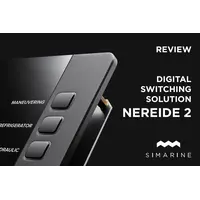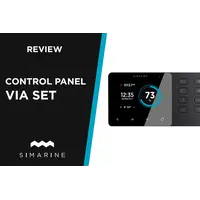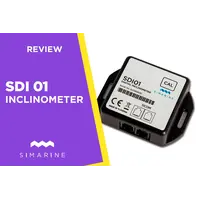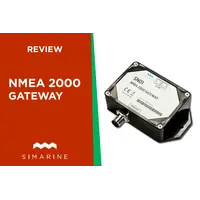In this review, topRik experts continues to discuss shunts and modules with which you can expand the capabilities of the Simarine PICO system monitor. This system is designed to monitor the condition of batteries, and in some versions, the level of liquids in tanks and temperature with the ability to issue an alarm signal if there are deviations from the set level of water or fuel.
topRik marketplace presents low-amperage shunts and Quadro shunt modules: SCQ25, SCQ50 and SCQ25T. They will help you expand your control area and thus enhance safety on your yacht. Their main task is to monitor the household appliances and electrical appliances on the yacht: refrigerator, electric stove, generator, wind generator, etc. with maximum constant current 25 A and 50 A.
And a surprise awaits you: behind the external similarity of the SCQ25T shunt module, additional capabilities are hidden, which we will discuss below.
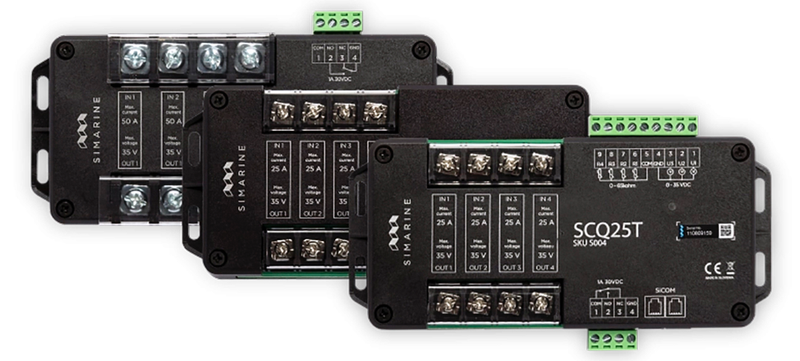
Key Features and Specifications
Quadro low current shunts and shunt modules have inputs for connecting four devices that consume or produce electrical current. These could be household appliances such as a freezer, washing machine, electric oven or stove, or a generator, solar panels, etc.
Low-current Quadro shunts will monitor the consumption and output of this equipment in real time, and all data will be reflected on the Simarine PICO display of the corresponding version.
And let's not forget about the possibility of connecting an alarm relay, which can be programmed to certain parameters. But remember that the alarm relay voltage limit is 60V and the current limit is 1A.
When choosing optional modules, the first thing you need to know is what inputs each one provides and what you can connect to them. Inputs offered by the Simarine PICO System Monitor are as follows:
- Resistance (for connecting resistive type sensors to monitor tank level or tank temperature).
- Voltage (for connecting volt sensors for tank level monitoring, custom sensors, or using the input for battery monitoring).
- Current (comprehensive battery monitoring, which is accompanied by a battery voltage reading from one of the above-mentioned voltage inputs).
Now let's look at the capabilities of each Quadro model and find out what makes them special. No, we haven’t forgotten about the surprise, more about it below.
SCQ25
The low current measurement and control shunt Quadro SCQ25 is ideal for small consumer loads. It allows a maximum continuous current of 25 A per channel in a 12 or 24 V battery system.
But if you want to increase the current per channel, you can combine the capabilities of the two channels by connecting them in parallel, and set this parameter in the PICO settings to control the two channels as one device. This will double the continuous current limit to 50 A, although the peak current can reach 70 A, which we do not recommend.
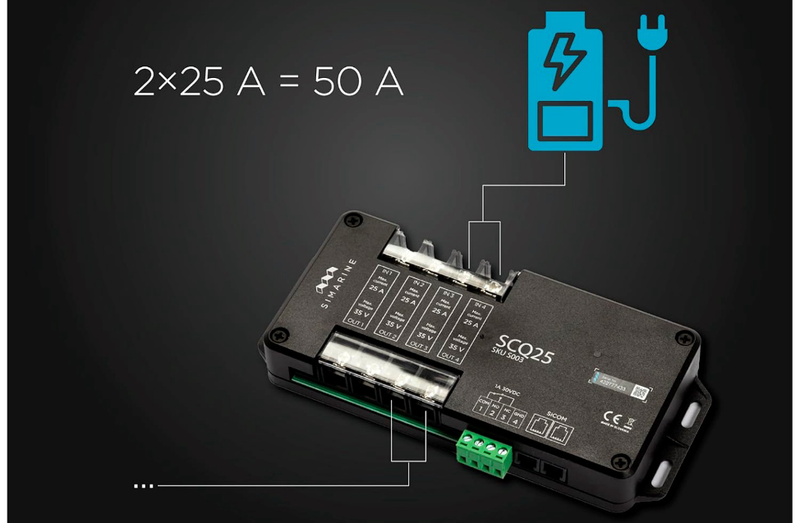
And to prevent exceeding 50 A, you can use a very useful option - an alarm relay.
The operating range of current measurement (per channel) is from 0.01 to 25 A.
Operating Characteristics
- Voltage range: 6 – 35 VDC
- Temperature range: from –20°C up to 70°C (–4°F up to 158°F)
- POWER CONSUMPTION AT 12 V
- Operating: 2.5 mA
CURRENT MEASURING (PER CHANNEL)
- Range: 0.01 – 25 A
- Accuracy: ±1%
- Resolution: 0.01 A
- Sampling rate: 100 ms
MAXIMAL CURRENT
- Voltage drop at 300 A: 30 mV
- Continuous: 25 A
- Peak current (<1min): 35 A
- DIMENSIONS: 183 X 91 X 34 mm
- Current channels: 4
- CONNECTIVITY: SICOM
- ALARM CONTACT: 1
SCQ50
This shunt performs the same functions as the previous one. What makes it different is that the SCQ50 allows a maximum DC current of 50 A per channel in a 12 or 24 V battery system. The operating range of current measurement per channel is from 0.01 to 50 A.
When connecting channels in parallel, you can double the continuous current limit per channel to 100 A if you also adjust this parameter in the PICO settings to control the two channels as one device.
SCQ50 allows you to connect 4 household appliances (refrigerator, hob, signal lights, lighting, solar panel, etc.) and 1 alarm relay.
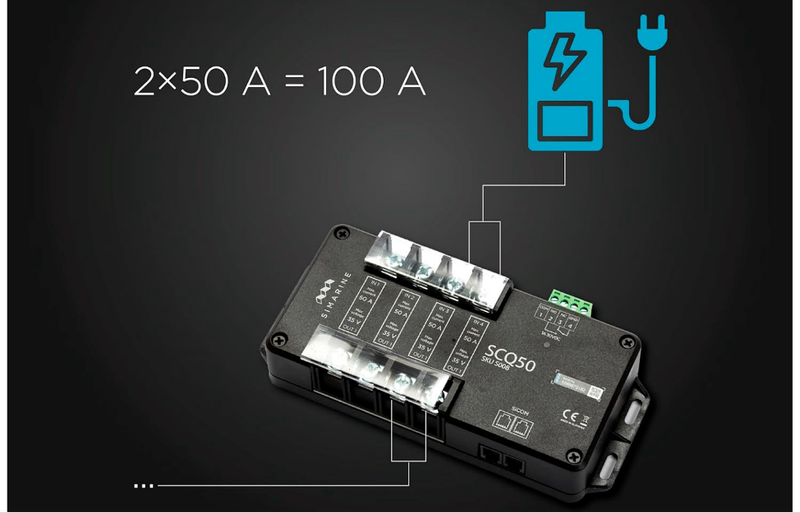
Operating Characteristics
- Voltage range: 6 – 35 VDC
- Temperature range: from –20°C up to 70°C (–4°F up to 158°F)
- POWER CONSUMPTION AT 12 V
- Operating: 2.5 mA
CURRENT MEASURING (PER CHANNEL)
- Range: 0.01 – 50 A
- Accuracy: ±1%
- Resolution: 0.01 A
- Sampling rate: 100 ms
MAXIMAL CURRENT
- Voltage drop at 300A: 35 mV
- Continuous: 25 A
- Peak current (<1min): 35 A
- DIMENSIONS: 183 X 91 X 34 mm
- Current channels: 4
- CONNECTIVITY: SICOM
- ALARM CONTACT: 1
SCQ25T - Differences from Models SCQ 25 and SCQ 50
And here is the promised surprise - the most versatile digital shunt module Simarine Quadro SCQ25T, which can be used not only to measure voltage and current, but also to control liquid levels in tanks and temperature. It combines the functionality of two Simarine level and voltage modules – SCQ25 and ST107.
The SCQ25T's 4 built-in 25A shunts are capable of measuring voltages up to 35V DC and DC currents up to 25A on each shunt.
Quadro SCQ25T digital shunt module can also measure the temperature or liquid level of a fuel tank or fresh and sea water tanks, as well as waste water and any other liquid.
The module is equipped with 4 built-in resistance inputs that operate in the range 0 ohm –65 kohm. 3 built-in voltage inputs operate in the range 0 – 32 V.
The SCQ25T also features a configurable alarm contact that activates when certain alarms occur. It can handle max. current 1A at max. 30 V DC. The alarm is configured via the PICO menu. The delivery package for Simarine SCQ25T includes a SiCOM cable.
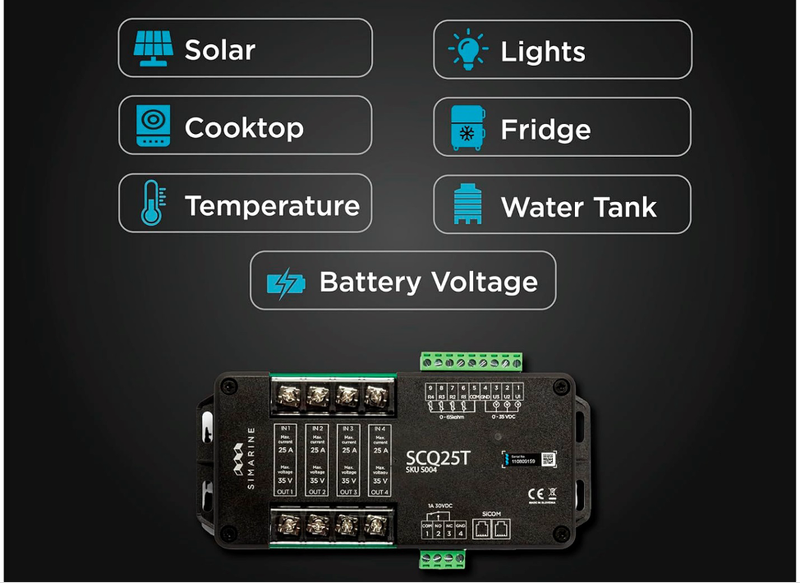
Operating Characteristics
- Voltage range: 6 – 35 VDC
- Temperature range: from –20°C up to 70°C (–4°F up to 158°F)
- POWER CONSUMPTION AT 12 V
- Operating: 2.5 mA
CURRENT MEASURING (PER CHANNEL)
- Range: 0.01 – 25 A
- Accuracy: ±1%
- Resolution: 0.01 A
- Sampling rate: 100 ms
MAXIMAL CURRENT
- Continuous: 25 A
- Peak current (<1min): 35 A
- VOLTAGE INPUTS (U1, U2, U3): 3
- Range: 0 – 75 VDC
- Resolution: 1 mV
- Accuracy: ±0.3%
- Sampling rate: 100 ms
- RESISTANCE INPUTS (R1, R2, R3, R4): 4
- Range: 0 Ohm – 65 kOhm
- Accuracy: ±3%
DIMENSIONS
- 183 x 91 x 34 mm
- 7.20 x 3.58 x 1.33 in
- CONNECTIVITY: SICOM
- ALARM CONTACT: 1
Installation and Configuration
When installing and configuring Quadro low-current measuring shunts, you must strictly follow the connection and operating instructions from the manufacturer Simarine. If the crew does not have an electrician with the appropriate approvals, a specialist should be invited for this work. If experience allows, installation and configuration can be done on your own in compliance with all safety requirements for electricians and using special tools and protective clothing.
You can also mix the shunt wires, connecting some to the positive and some to the negative pole, or even to the same module. Multiple shunts can be connected in series or connected to our other expansion modules.
Installation and Configuration of SCQ25 and SCQ50
If the voltage of the entire system does not exceed 35 V, shunts SCQ25 and SCQ50 can be connected to both the LOW (-) and the HIGH side (+). If the system voltage is higher than the specified value, then a mandatory connection is required only to the LOW (-) one.
The design of the shunts is so safe that they can be connected through either the positive or negative cable of the battery.
Installation and Configuration of SCQ25T
During the installation of the universal module, you can connect to it any tank (fuel, fresh water, waste water, boiler) or temperature sensor operating in the same range as the SCQ25T.
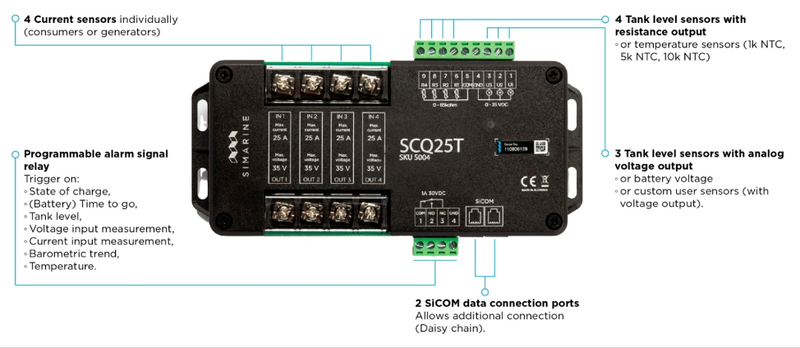
Functionality and Integration
From the information above you can see that Quadro shunts and modules significantly expand the capabilities of the Simarine PICO system monitor. In addition to their usual purpose, Simarine shunts and shunt modules, integrated into the yacht's electrical system, are able to:
- remove current from a system or component;
- prevent overcurrent;
- control the data of batteries of almost any type (with the correct choice of shunts and shunting devices and the method of their installation in the yacht’s electrical system);
- monitor batteries for any purpose: starter (voltage) or service battery, charger input, solar panels;
- control the fuel level in the tank;
- monitor the level in fresh, sea, hot water and waste water tanks;
- monitor the temperature conditions of specified objects through sensors;
- display information about the status of connected batteries on the screen;
- display data from tank level sensors on the screen;
- display temperature sensor data on the screen;
- give a programmed alarm in case of battery malfunctions;
- generate a programmed alarm in the event of a critical change in the level of liquids in the tank or temperature.
All shunts and modules are compatible with the Simarine PICO battery monitor and Via control panel.
And all of them are applicable to expanding the electrical system not only of boats, but also of campers, trailers, and motorhomes.
By the way, Via is a digital switching specifically for vans, which was previously called Caravan Control. It is also compatible with additional expansion devices SC303/503, ST107, SCQ25, SCQ50, SCQ25T, as well as other Simarine shunts and modules. A very well thought out control system with dual purposes - at sea and on land.
When integrating Simarine shunts and modules, consideration should be given to their compatibility with battery and sensor types.
The complete battery monitoring system is suitable for all types of batteries, including lithium, especially recommended for service batteries. For full battery monitoring you will need a voltage input and a current input.
To monitor the tank level, the system supports almost any resistive as well as analog (voltage) tank level sensors. The voltage and resistance ranges are quite wide, which allows the use of almost any sensor of the mentioned types in the system:
- voltage range: 0.0 – 75.0 V;
- resistance range: 0 Ohm – 65 kOhm.
For each sensor you will need 1 voltage input or 1 resistance input depending on the type of sensor.
Only resistive type sensors are suitable for temperature monitoring, hence the need for a resistance input for every temperature sensor. But some models of shunts and shunt modules have a separate input specifically for the temperature sensor, so carefully study the instructions included with the delivery with the technical characteristics of each module.
With Simarine PICO system monitor is compatible with the following sensors with the following capabilities to read a specific temperature range:
- NTC 10k – down to –13°C;
- NTC 5k – down to –20°C;
- NTC 1k – down to –40°C.
Technical Support and Service
Already by the variety of the Quadro version, which presents shunts for different current strengths of 25 A and 50 A, as well as a shunt module with tank level and temperature monitoring capabilities, it is clear that the manufacturer is constantly updating, improving and expanding the capabilities of the Simarine PICO system monitor. Therefore, if you have this monitoring system installed on your yacht, it makes sense to keep an eye on updates and new products.
For example, the current Simarine shunts and shunt modules that work in your yacht's electrical system can also be used in the Via digital switching system for RVs and motorhomes.
Another recent innovation is the ability to remotely monitor a yacht’s batteries and tanks. By leaving your boat at the dock and going for a walk or grocery shopping in town, you can monitor the condition of your batteries. However, this will be possible not only from the nearby city. You can use this new app to monitor your tank level, temperature and other measurements from anywhere in the world. Just check if your PICO version allows you to use this application.
topRik experts do not recommend installing, configuring or reconfiguring any version of Simarine PICO system monitor on your own, since the manufacturer provides a fairly decent warranty for a period of 3 years. Moreover, in the event of a malfunction of the system or its components during this period, you are provided with free technical service, including repair or replacement of the faulty part.
Warranty obligations are terminated if you, without the written permission of the guarantor, reinstall or reconfigure the system, replace its parts, or otherwise interfere with its circuits, as specified in the warranty agreements.
In case of malfunctions in the system or incorrect operation of shunts, shunt modules and other parts, you must contact the manufacturer or a certified technical service center within the specified period. Violation of this period will also result in denial of warranty service. So, carefully read the manufacturer's warranty agreement.


